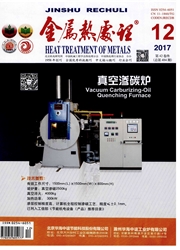

 中文摘要:
中文摘要:
为了改善钛合金和不锈钢的耐磨性,对Ti6Al4V合金和AISI420马氏体不锈钢表面进行真空辉光离子渗Cr,对比研究了合金化层的组织结构和摩擦磨损性能的相关性。结果表明,两种基材的合金化改性层厚度均达60μm以上,结构致密,结合强度高。Ti6Al4V合金改性层由Cr沉积层、富Cr2Ti层、CrTi4层和Cr-Ti固溶层组成,其中富Cr2Ti层硬度最高,是基材的2.3倍;AISI420不锈钢渗Cr层由Cr沉积层和扩散层组成,扩散层中富含Cr23C6相,二者过渡区的硬度最高,是基材的4.5倍。表面渗Cr显著提高两种材料的耐磨性,这与渗Cr层的物相结构有关。Ti6Al4V合金的Cr沉积层和富Cr2Ti相层均具有优异的耐磨性,而固溶层的耐磨性较差;AISI420钢基材的Cr沉积层和过渡层均具有优异的耐磨性,而扩散层的耐磨性稍差。渗Cr处理使两种基材的磨损机制均由磨粒磨损为主转化为粘着磨损为主。
 英文摘要:
英文摘要:
Glow plasma chromizing was conducted on the surface of Ti6Al4V alloy and AlS1420 stainless steel respectively to improve their wear resistance. Effect of microstructure on the friction and wear properties of the alloyed layers was also investigated. The results stlow thai both alloyed layers are more than 60 μm in thickness. The alloyed layers have good compactness and high bonding strength. The alloyed layer on Ti6Al4V substrate consists of Cr-deposited layer, Cr2Ti-rieh layer, CrTi4 layer and Cr-Ti solid solution layer. The Cr2Ti-rich layer has the highest hardness (2.3 times of thai of Ti6AI4V substrate) ; The alloyed layer on AIS1420 substrate contains the Cr-deposited layer and Cr23C6-rich diffusion layer. Moreover, the transition zone between Cr-deposited layer and diffusion layer has the highest hardness (4.5 times of that of AIS1420 substrate). The ehromized layer can improve the wear resistance of the two substrates remarkably, which closely relates to the phases of the chromized layers. For Ti6Al4V alloy, the Cr-deposited layer and the Cr2Ti-rich layer both have excellent wear resistance, while the Cr-Ti solid solution layer has poor wear resistance. For AIS1420 steel, the Cr-deposited layer and the transition zone have excellent wear resistance, while the inner of diffusion layer has poor wear resislance. the chromizing makes the main wear mechanism transfer from the abrasive wear to the adhesive wear for the two substrates.
 同期刊论文项目
同期刊论文项目
 同项目期刊论文
同项目期刊论文
 Tribology behavior of double-glow discharge Mo layers on titanium alloy in aviation kerosene environ
Tribology behavior of double-glow discharge Mo layers on titanium alloy in aviation kerosene environ Finite Element Method Analysis of the Stress for Line Pipe with Corrode Groove During Outdoor Storag
Finite Element Method Analysis of the Stress for Line Pipe with Corrode Groove During Outdoor Storag Application of plasma electrolytic oxidation to the novel aircraft aluminum alloy for enhancing corr
Application of plasma electrolytic oxidation to the novel aircraft aluminum alloy for enhancing corr Effects of prior Corrosion with and without stress on the mechanical properties of 7475-T761 aluminu
Effects of prior Corrosion with and without stress on the mechanical properties of 7475-T761 aluminu Fretting wear and fretting fatigue behaviors of diamond-like carbon and graphite-like carbon films d
Fretting wear and fretting fatigue behaviors of diamond-like carbon and graphite-like carbon films d Beam assisted deposition film for improving fretting fatigue resistance of Ti8Al1Mo1V alloy at eleva
Beam assisted deposition film for improving fretting fatigue resistance of Ti8Al1Mo1V alloy at eleva 期刊信息
期刊信息
